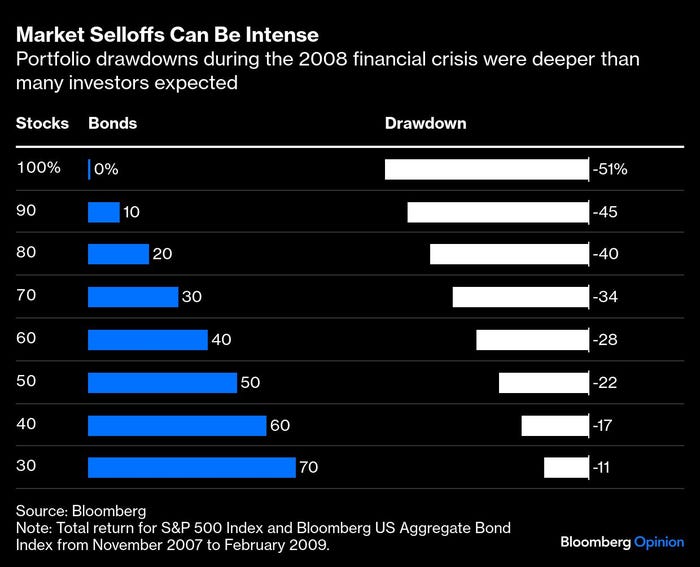(Bloomberg Opinion) —
Now that the stock market has momentarily stabilized from the shock of President Donald Trump’s “Liberation Day” tariffs, investors have an opportunity to reflect on how their portfolio held up during the past two turbulent weeks. If it sank more than they expected, there may be greater risk lurking there than they want or can tolerate.
People don’t think about risk much in a rising market. And when they do, they don’t focus enough on the essential question: How much of my money will evaporate in a crisis? The answer is more than you probably think, which explains why many investors were surprised by the depth of the declines during the 2008 financial crisis and the Covid pandemic — or even following Trump’s tariff announcement on April 2.
It’s not that investors don’t know that stock prices move in two directions, or that market selloffs, even severe ones, are very likely temporary setbacks. Unfortunately, it’s easy to forget when a portfolio is melting amid terrifying talk of an unprecedented, world-changing crisis — a soundtrack that always seems to accompany the worst market collapses.
The crisis chatter is so resonant because it rings true. Yes, every crisis is different. But it has never been different in the one way that matters most to investors. Namely, every crisis has ended with a market recovery, and usually sooner than anyone expects.
Still, navigating a declining market would be easier if investors were better prepared for drawdowns. One reason they’re not is that we talk about risk too abstractly. The conversation is often about volatility, which is helpful for understanding how investments normally behave. But crises — or disruptions such as sweeping tariffs that have the potential to trigger a crisis — aren’t normal, and standard measures of volatility don’t convey forcefully enough what happens in those moments.
The harsh reality is that an investment in the S&P 500 Index will get cut in half several times during an investing career. There have already been two such episodes since 2000 around the dot-com bust and the financial crisis. And the older you are, the more painful the drawdowns become because more dollars are usually at stake.
Imagine dutifully saving and investing for retirement for decades only to wake up one day to find that half of your money has vanished. Even if someone were to tell you all the right things in that moment — that the market will recover, and that even the most severe selloffs tend to last only a year or two — none of it is likely to be much comfort if your portfolio is down more than you expect or can stomach.
Another reason investors aren’t better prepared is that they take false comfort from aligning their portfolio with their age. Younger investors are nudged to own more stocks regardless of their drawdown tolerance, risking that some will abandon the stock market at the wrong time if the declines are deeper than they can handle. Older investors are encouraged to allocate less to stocks, but their portfolio can still be down much more than they expect.

Consider that during the financial crisis, a portfolio allocated 60% to the S&P 500 and 40% to the Bloomberg US Aggregate Bond Index would have been down 28% from November 2007 to February 2009, including dividends. A more conservatively postured 40/60 stock/bond portfolio would have still been down 17%.
The solution is to build portfolios with drawdowns specifically in mind. Here’s an easy way to do that: Multiply the first number of your percentage allocation to stocks by four and then five. The resulting two numbers represent, in percentage terms, the range of likely decline in a severe downturn. So, for example, a 70/30 stock/bond portfolio should be expected to decline somewhere between 28% and 35% in a bad storm before it recovers. If that drawdown sounds too intense, reduce your stock allocation and rerun the numbers until the expected drawdown is one you can live with.
Risk and return are related: The lower a portfolio’s stock allocation, the lower its expected return because stocks usually outpace bonds. Investors are likely to be best off taking as much drawdown risk as they can handle, but no more. Those who overestimate their drawdown tolerance and end up dumping stocks when they’re down would have probably been better off with a lower allocation to stocks to begin with. I know several investors who sold their stocks during the financial crisis because they were spooked by the deep declines. The world is collapsing, one warned me. The old playbook is out. Waiting for a market recovery is a fool’s game, he said. The market did recover beginning in early 2009, and this investor eventually bought stocks again, but not until prices were considerably higher than when he sold.
I also know investors who sold their stocks during the pandemic. That selloff was milder but potentially more destructive because it moved faster. It took the S&P 500 just over a month to hit bottom in March 2020, and it recovered nearly as quickly. Those who sold as the market dropped were almost guaranteed to buy back at much higher prices.
I have a sneaking suspicion there are more surprises ahead for the market. The best protection for investors against the inevitable bumps and potential crises: Know thyself.
More From Bloomberg Opinion:
Want more Bloomberg Opinion? OPIN <GO>. Or you can subscribe to our daily newsletter.
To contact the author of this story:
Nir Kaissar at [email protected]










